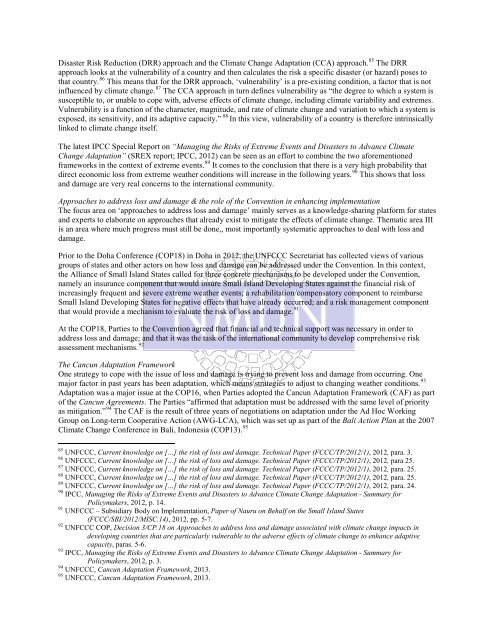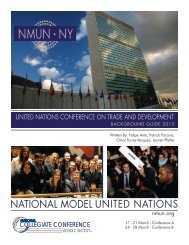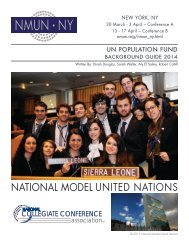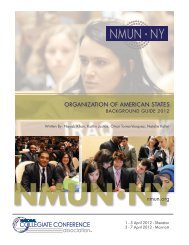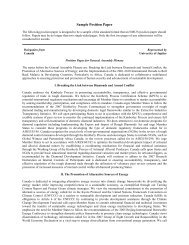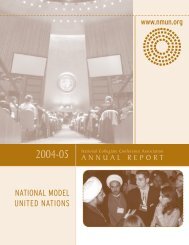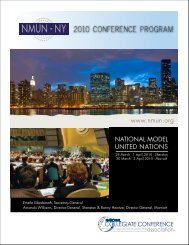NMUN • KOREA - National Model United Nations
NMUN • KOREA - National Model United Nations
NMUN • KOREA - National Model United Nations
Create successful ePaper yourself
Turn your PDF publications into a flip-book with our unique Google optimized e-Paper software.
Disaster Risk Reduction (DRR) approach and the Climate Change Adaptation (CCA) approach. 85 The DRR<br />
approach looks at the vulnerability of a country and then calculates the risk a specific disaster (or hazard) poses to<br />
that country. 86 This means that for the DRR approach, ‘vulnerability’ is a pre-existing condition, a factor that is not<br />
influenced by climate change. 87 The CCA approach in turn defines vulnerability as “the degree to which a system is<br />
susceptible to, or unable to cope with, adverse effects of climate change, including climate variability and extremes.<br />
Vulnerability is a function of the character, magnitude, and rate of climate change and variation to which a system is<br />
exposed, its sensitivity, and its adaptive capacity.” 88 In this view, vulnerability of a country is therefore intrinsically<br />
linked to climate change itself.<br />
The latest IPCC Special Report on “Managing the Risks of Extreme Events and Disasters to Advance Climate<br />
Change Adaptation” (SREX report; IPCC, 2012) can be seen as an effort to combine the two aforementioned<br />
frameworks in the context of extreme events. 89 It comes to the conclusion that there is a very high probability that<br />
direct economic loss from extreme weather conditions will increase in the following years. 90 This shows that loss<br />
and damage are very real concerns to the international community.<br />
Approaches to address loss and damage & the role of the Convention in enhancing implementation<br />
The focus area on ‘approaches to address loss and damage’ mainly serves as a knowledge-sharing platform for states<br />
and experts to elaborate on approaches that already exist to mitigate the effects of climate change. Thematic area III<br />
is an area where much progress must still be done,, most importantly systematic approaches to deal with loss and<br />
damage.<br />
Prior to the Doha Conference (COP18) in Doha in 2012, the UNFCCC Secretariat has collected views of various<br />
groups of states and other actors on how loss and damage can be addressed under the Convention. In this context,<br />
the Alliance of Small Island States called for three concrete mechanisms to be developed under the Convention,<br />
namely an insurance component that would insure Small Island Developing States against the financial risk of<br />
increasingly frequent and severe extreme weather events; a rehabilitation/compensatory component to reimburse<br />
Small Island Developing States for negative effects that have already occurred; and a risk management component<br />
that would provide a mechanism to evaluate the risk of loss and damage. 91<br />
At the COP18, Parties to the Convention agreed that financial and technical support was necessary in order to<br />
address loss and damage; and that it was the task of the international community to develop comprehensive risk<br />
assessment mechanisms. 92<br />
The Cancun Adaptation Framework<br />
One strategy to cope with the issue of loss and damage is trying to prevent loss and damage from occurring. One<br />
major factor in past years has been adaptation, which means strategies to adjust to changing weather conditions. 93<br />
Adaptation was a major issue at the COP16, when Parties adopted the Cancun Adaptation Framework (CAF) as part<br />
of the Cancun Agreements. The Parties “affirmed that adaptation must be addressed with the same level of priority<br />
as mitigation.” 94 The CAF is the result of three years of negotiations on adaptation under the Ad Hoc Working<br />
Group on Long-term Cooperative Action (AWG-LCA), which was set up as part of the Bali Action Plan at the 2007<br />
Climate Change Conference in Bali, Indonesia (COP13). 95<br />
85 UNFCCC, Current knowledge on […] the risk of loss and damage. Technical Paper (FCCC/TP/2012/1), 2012, para. 3.<br />
86 UNFCCC, Current knowledge on […] the risk of loss and damage. Technical Paper (FCCC/TP/2012/1), 2012, para 25.<br />
87 UNFCCC, Current knowledge on […] the risk of loss and damage. Technical Paper (FCCC/TP/2012/1), 2012, para. 25.<br />
88 UNFCCC, Current knowledge on […] the risk of loss and damage. Technical Paper (FCCC/TP/2012/1), 2012, para. 25.<br />
89 UNFCCC, Current knowledge on […] the risk of loss and damage. Technical Paper (FCCC/TP/2012/1), 2012, para. 24.<br />
90 IPCC, Managing the Risks of Extreme Events and Disasters to Advance Climate Change Adaptation - Summary for<br />
Policymakers, 2012, p. 14.<br />
91 UNFCCC – Subsidiary Body on Implementation, Paper of Nauru on Behalf on the Small Island States<br />
(FCCC/SBI/2012/MISC.14), 2012, pp. 5-7.<br />
92 UNFCCC COP, Decision 3/CP.18 on Approaches to address loss and damage associated with climate change impacts in<br />
developing countries that are particularly vulnerable to the adverse effects of climate change to enhance adaptive<br />
capacity, paras. 5-6.<br />
93 IPCC, Managing the Risks of Extreme Events and Disasters to Advance Climate Change Adaptation - Summary for<br />
Policymakers, 2012, p. 3.<br />
94 UNFCCC, Cancun Adaptation Framework, 2013.<br />
95 UNFCCC, Cancun Adaptation Framework, 2013.


